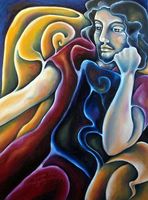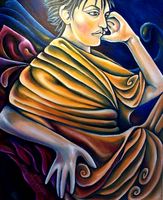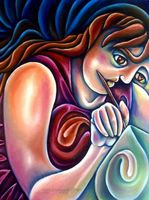
P303 History
14x11" acrylic on canvas
private collection
This little picture has for its theme history, the idea that we sometimes hold onto our history...here the woman is almost clutching it to her breast.
Paleozoic Series


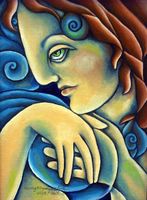
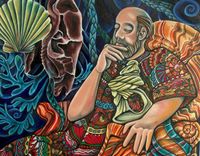
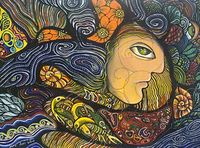



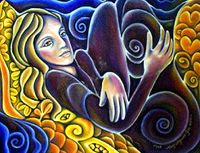




P278 Fossil Glyph
12x9" oil on canvas
$100.00
May 15, 2001: After working on some Latin at the kitchen table, I went back upstairs to work on P277 a bit more. The idea of the glyph troubled me in a rather pleasant way, so I took a small canvas (P278) and sketched my own version of one of the Mexican glyphs, transformed into an organic shape, fossilized. I was very pleased with the image, which resembles the first Palaeozoic fossil I painted. As well, I dabbled at an unfinished watercolour in my sketchbook, a fossil made up of masks.
May 16, 2001: This evening I worked in the studio, on P277, and also did some of the under-painting on P278. As soon as I had stained the glyph of P278, orange, it took on the appearance of a scarab or beetle. Or even a mask. I am ridiculously pleased with this little picture, probably because it is the first new work in some time. I am beginning to have fun again. In a burst of optimism I prepared another small panel.
June 24, 2001: I worked on the new painting, P278, the small fossil that resembles a heart or an eye, originally inspired by a Mexican glyph. At first I had no enthusiasm for it, since I have been away from the idea for some time. My tentative glazes ran and blurred, and the limited palette seemed uninteresting. But as usual, the application of chiaroscuro and the addition of a warm yellow made my new creature come alive. It probably good that I have a small picture to dabble at, since I am at present unclear on the direction the series will take.
June 29, 2001: The wind hisses through the trees, rising and falling, and the day has remained hazy after last night's torrential rain. I love the feel of the air, as if everything is renewed, everything extra washed away. The colours are brighter, another reason to like such a day. I work outside a little, listening and smelling, and then come up to the studio to escape the midday heat, which is bad for my condition. I have been picking away at the little glyph painting, P278, thinking about some new paintings.
Last night, when I couldn't sleep, I thought of new paintings, perhaps a new series, for the first time. I have been thinking of knots as the visual representation of dilemmas or ideas. Also the homonym of knot, not intrigues me. Not (knot) theory. It may be a step toward the abstraction I seek. I must play with it a little. I am reminded of the knots I began using in the Sanctuary Series. Above all, though, I do not wish them to be perceived of as negative, just what things are not, or the tangle of trying to get to the truth or basic, untainted idea.
July 4, 2001: Still wondering where P278 is going, but at least I am working on it this morning. Its fleshy coils look as though they should mean something, and I suppose that is the whole point of abstraction or near abstraction...the mind attempts to resolve the pattern before it. It comes around, again and again, sparking new ideas, but always returning to the abstract. It is that abstracted state of mind we try to achieve, anyway, when we are looking for enlightenment. This is not an abstract, surely, for it appears figurative, but it is unnameable, unrecognizable. This was how the Mexican glyphs affected me, so many of them simply a pattern that was almost something, organic or geometric, but always just slipping off the symmetry of recognition.
As if to underline that feeling, the music I am playing this morning is equally fugitive, Tippett's Symphony #4. At times I think there is a flaw in the disk, but then melody creeps in. Now I am laughing at myself, because the disk was skipping after all. But it was a wonderful moment, the way the sound matched the painting and my thoughts.
The painting is equally silly to me at times, but that may also be the point, that art is about everything we think, not always profound or meaningful. I simply make it all into my patterns, pleasing in cadmium orange and Prussian blue. I keep wanting to make fun of the little painting, but when I come up on it, after being out of the room, I am drawn to it. It is my daring step, my willingness to make a mistake, to paint something bad.
July 11, 2001: ...The multi-coloured fossil glyph(P278) is beginning to resemble some exotic fruit. The addition of yellow was unfortunate, I think. I want to go upstairs and do something about it, but I seem immobilized here. Why am I writing about a rock concert? But I am really writing about self-satisfaction and dearth of passion in art. Dabbling without heart, mouthing to the lyrics, without voice. Maybe that glyph is my heart, turned into an over-ripe fruit, crystallizing into a gaudy fossil. Where is the integrity of the idea? I dare not get back to work on the large hanging, until I have my head and heart back into the idea. At least I did not paint this bauble into a major work.
For a while this morning, I actually considered painting over the picture, and I may still do that, rather than waste more time on it. What is stopping me is my periodic interest, over the past few weeks, in the idea. At one point I was quite enthralled with it, colours and all. Often, just past the halfway point in a painting, I am quite out of love with the entire idea or the way I have done it. Seeing it through usually resolves things. But I should not be too hesitant about tossing aside a bad idea, either, and moving on.
July 25, 2001: This is where it gets interesting. After getting dressed this morning, I wandered around doing some small chores and feeling depressed and hopeless. Well, the writing is going well, but the little painting I just finished, P278, the fossil glyph is gloomy-looking. I consider brightening it up. I bring it down to the kitchen, yes the kitchen, and bring the French easel in from the deck. It's very cold and grey today, so I am thinking I might pick away at the little fossil woman here in the kitchen, which is almost the deck, since I have the same view.
The fossil glyph doesn't look nearly so gloomy and dull down here, especially when the sun suddenly comes out, and the little picture glows. It is subtle, I think, less brilliant than some of the other paintings in the series. I will leave it, as I think I already knew I would. What is the point in going back over a painting that is done? You are already a different person, a different artist, than the day you finished that picture. And it would be a different painting. Better to make another version of an idea, than paint over an existing one. It would be like writing over journal entries. I feel differently almost every day, about the same things.




